

 Pertubuhan-pertubuhan Melayu Bersatu Menentang ‘Malayan Union’ (1946). This work was not actually exhibited
Pertubuhan-pertubuhan Melayu Bersatu Menentang ‘Malayan Union’ (1946). This work was not actually exhibited
Finding myself at a loss one afternoon during the Umno general assembly, I decided to take a stroll through PWTC. I passed the entrance to Merdeka Hall, where speeches and sycophancy continued, rounded the corner – and, lo and behold, discovered a painting exhibition.
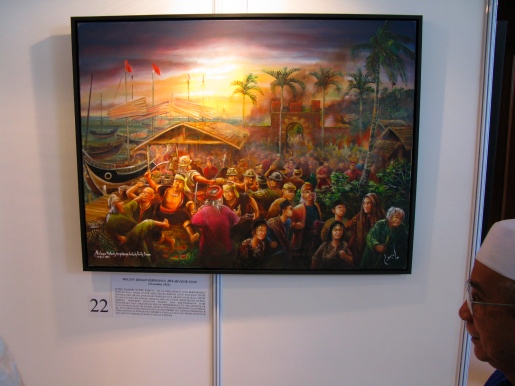 Melayu Kedah terpedaya helah licik Siam (12 Nov 1821), at the Umno GA
Melayu Kedah terpedaya helah licik Siam (12 Nov 1821), at the Umno GA
The works hung on white expo screens, in a zig-zag in the PWTC foyer. Baju Melayu-ed delegates glanced as they hurried past, hangers-on strolled by, and the curious public might have even stopped a while: Perjuangan Abadi Bangsa Melayu, by one Ismail Embong.
It was a series of scenes depicting historical mayhem. Here’s one: Armada Melayu Melaka patahkan serangan Siam (1445), a vast battle with boarding actions, lit sails, and stricken seamen falling into the waves. The catalogue, which I purchased, had the following to add about Tun Perak’s display of naval prowess:
“Siam telah lari dikejar sehingga ke Singapura dan tidak lagi mengancam Melaka.”
 Armada Melayu Melaka patahkan serangan Siam (1445)
Armada Melayu Melaka patahkan serangan Siam (1445)
Another one, simply titled Melaka (10 Ogos 1511) records the the fall of Malacca, and has wild-faced, moustached warriors facing off with armoured, bearded pikemen. Ismail believes that, since then, his race’s struggle for survival has never ended. From his statement in the catalogue:
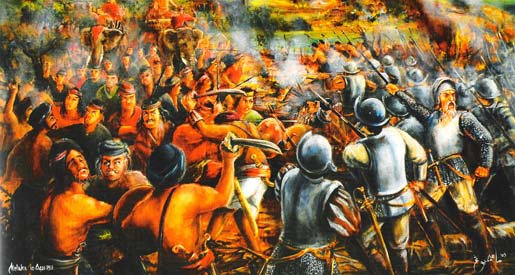 Melaka (10 Ogos 1511)
Melaka (10 Ogos 1511)
“Ribuan nyawa Melayu terkorban memperjuangkan dan memperkasa kedaulatan itu, termasuk di tangan ‘anak jajahan’ yang di bawa masuk sebagasi polis dan tentera untuk memusnahkan penentangan Melayu. Jutaan keturunan asing didatangkan menyokong pemerintahan, pentadbiran, ekonomi dan penindasan kolonialisme British. Anak jajahan itu kemudiannya menikmati segala kemudahan dan kesenangan hidup itu hingga kini. Setelah hampir 500 tahun pengorbanan dan perjuangan demi keperkasaan kedaulatan Melayu, apakah kita akan melepaskan kedaulatan dan kenegaraan Melayu itu begitu sahaja….”
Episodes of impassioned defences (Melayu Acheh patahkan serangan Portugis (Acheh, Mei 1521)), heroic ambushes (Melayu Rembau serang hendap angkatan Gabenor Belanda (3 Februari 1643)), and blitzy economic sabotage (Melayu Naning menjarah kebun & harta Portugis & Serani (1586)) ensue.
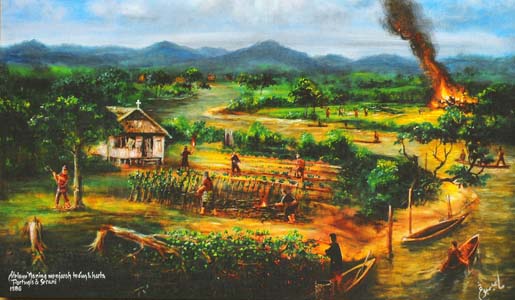 Melayu Naning menjarah kebun & harta Portugis & Serani (1586)
Melayu Naning menjarah kebun & harta Portugis & Serani (1586)
The oils are neither fine nor impassioned, and manage a cartoony, History-textbook air at best; there’s no way to tell if the battles happened at the scale or complexity as they are painted. Those questions aren’t important, as technical or factual verisimilitude aren’t Ismail’s main aim. The paintings struck me as emulations of Houel‘s The Storming of the Bastille and its like: violence choreographed in epic scale, of grand empires and popular movements wrestling with each other for dominance in continental fates.
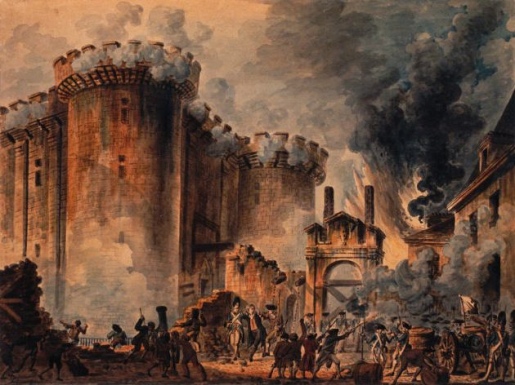 Jean-Pierre Houel’s The Storming of the Bastille. From Wikipedia
Jean-Pierre Houel’s The Storming of the Bastille. From Wikipedia
Ismail’s works function as propaganda, yes; the fact that they were at the general assembly is proof enough. They were wrong-minded and xenophobic. The artist’s stated premise is identical to Umno’s: an artful meld of We Are Mighty Sovereign! and We Are Under Threat of Extinction! with a whisper of Spill the Blood of Foreigners!
But I love myth-making. Stuff like cannonades and burning forts always get to me.
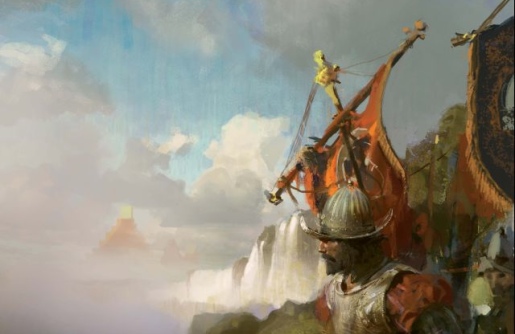 Detail of Europa Universalis 3 concept art, by Craig Mullins
Detail of Europa Universalis 3 concept art, by Craig Mullins
A while back I got obsessed with a game called Europa Universalis 3. Based on a board game that only let players command one of seven European powers, the electronic iterations shed this limitation; you could play as any significant realm that existed on Earth between 14 October 1399 and 2 February 1821, and lead it to imperial glory.
My instinct, as soon as I had the chance, was to take the Sultanate of Malacca for a spin. By the mid-15th Century, I counted all the Sunni kingdoms in the neighbourhood as allies, and was waging – and losing – a holy war against the Buddhist / Hindu infidels to the north. Eventually, I’d give the White Man a run for his ducats.
 A Malacca EU3 game in progress. From this thread
A Malacca EU3 game in progress. From this thread
That was how EU3 hooked me: the fact that I could take a fledgeling state and achieve alternate-history world domination. It was the visual pleasure of seeing a blob of blue on the map, against insurmountable odds, slowly cannibalise Ming China.
The kick that Civil War re-enactors – or Victoriana enthusiasts, or Vampire role-players, or artists of historical paintings – get out of their past-times, I imagine, are similar: they are all flights of what-if splendour, grounded in a springboard of real-world conjecture. The exercise of history, after all, is largely a speculative fiction.
 Simulation of the Battle of Chancellorsville. From Wikipedia
Simulation of the Battle of Chancellorsville. From Wikipedia
So I ignored the matters of national importance around me – I was sick of it – for a while, and thought I saw an earnestness in these bloody episodes. As they unfolded before me, I pretended to hear the painter saying: “This could have happened; this is my vision of what should have happened, and I want to share this cool scene in my head by putting it on canvas.” Hopefully, the artist himself was aware at the subjectivity of his works – that Melayu Kedah terpedaya helah lick Siam (12 Nov 1821) was his interpretation, and that he welcomed my perspective, if I had one.
 Tunku Muhamad Sa’ad tawan Kota Kuala (1828)
Tunku Muhamad Sa’ad tawan Kota Kuala (1828)
I imagined a discussion about the correct dimensions of Portuguese galleons or the exact shade of an Acehnese banner. I considered the possibility that Ismail and I could have had an argument about the kind of musket the Bugis used in the 18th Century – just two buffs beating each other up about facets of our ceaselessly interesting, syncretic history. I wanted to believe it.
Next to the catalogue counter, a chatty man was holding court. I think he was waiting for people to ask him for his autograph. I dared not approach, or even glance for too long.
(ZS)
PS: Happy 13 May 1969!
Sorry, the comment form is closed at this time.
Yo Z,
The cartoonishness and the propaganda quality of the art reminded me of the comics of Jack T. Chick
http://www.jackchickmovie.com/
I have several booklets :)
What kind of strategy you adopted to expand Malacca so far? Hoy Cheong took it all the way to Austria leh.
Check out how Japan depicted the demon ships (Yankees). Its not event history but its already fictionalized :P
http://ocw.mit.edu/ans7870/21f/21f.027/black_ships_and_samurai/bss_visnav04.html
There’s no firm ground to stand on these days. Everyone is flying around. Some are afraid. Some are having a blast.
D3K
Hey Dan-dan:
Yeah, Jack Chick. I grew up in a sorta evangelical family, so his outrageous tracts were always floating around.
In EU3 you can do the world conquest thing with any nation — but it’s just really tedious with some. With Malacca (since you start out as a minor Asian kingdom) it means knowing the core mechanics of the game’s AI, and crunching a lot of numbers. I never had the requisite patience to do it.
Oh my god, I love those black ships! Your mention of Japanese depictions of the White Man reminded me of an episode of the anime Samurai Champloo: Americans arrive in Edo-era Japan, and the fate of the locals hinges on a game of baseball.
http://www.youtube.com/watch?v=lKwXwk7jA9c
Wee!
Jack Chick has a movie? Amazing! Love him to bits. Anyone know how he looks like?
Just look at the figure on the right in the Tunku Muhamad Sa’ad painting (last image). He almost has a smile on his face. Either he’s on a gleeful rampage or he’s running amok.
Hopefully, the artist himself was aware at the subjectivity of his works – that Melayu Kedah terpedaya helah lick Siam (12 Nov 1821) was his interpretation, and that he welcomed my perspective, if I had one.
Tough chance, but who knows? :)
Happy 13 May 1969, indeed!
Hey Simon:
Apparently, Tunku Muhammad Sa’ad “telah berjaya meluaskan kawasan pertempuran sehingga Haadyai dan Singgora”. Then he “terpaksa bertempur dengan pasukan Siam yang lebih besar dan mengundurkan diri ke Kedah”.
As for Ismail Embong understanding multiplicity, well, it was a passing daydream. Like how we dream of wings, or clean government. Doubt he would have listened to me, anyway — me being an anak jajahan and all.
I like how the chinese fler in the first pic stands to the side and has his arms folded while the Sikh folks look on as if they are comparing head gear with that of the Ulamak dude.
For some reason I find these paintings really compelling and… ahem… desirable. As in wouldn’t mind having one in my house kind of desirable.
In the whole Malaysian art meriam (canon – heheh.. ehrh.. nvmind) I can’t think of a historical painter. We have the social realists like J Anu, the pioneer landscape painters, stylists, conceptualists, and painters of personal experience, etc. But historical painting? Hmm. Closest I can think of is Fuad’s Recollections of Long Lost Memories paintings – but those were reworking photographic images.
Zee Zee,
Is the first image the most modern historical event painted by the artist? It’s pretty interesting how the composition no longer uses a kind of panoramic and clear binary system as compared to the ones below where there are dramatic clashes taking place.
The clash here is no longer physical but in terms of the mix of languages (inggrish,jawi, mlahyu) used in the demo signs, as well as in how the relatively more active and angry crowd blend in with the cool bystanders. In ‘peace’ time, the battle has thus become a kind of internalize conflict based on codes related to law, culture, race, religion, etc.
Do you know of any games that factors in these fuzzy elements as much as the more quantifiable stuff like territory, army size, economic power?
A kind of game without clear winner since its possible to have conqured Ming China yet you might end up with Malaccan Empire that drops its native traditions and adopts Orientalist culture?
Sharon,
I can’t think of an official Malaysian history painter of the top of my head but it might be much better this way. I believe it is possible to regard any work as a form of time capsule regardless of the subject matter. It’s the duty of future curators, critics and historians who then has to dig around and help viewers piece together the story(s). Future historians actually have to be especially careful with artists who consciously use history as content since most are usually used as propaganda as examplified in the case here.
DC
Hey Dee Dee:
No, actually. The catalogue ends with Padang Bandar Hilir Melaka (20 Feb 1956), which shows Tunku Abdul Rahman raising a keris in declaring self-rule. The caption:
“Akhirnya bangsa Melayu memilih untuk merdeka dan berkerajaan sendiri dalam damai melalui perundingan dengan kuasa penjajahan lalu mencapai kembali mercu kedaulatan dan kemuliaan bangsanya …”
So not a battle, even. Only three pieces in the series are non-violent. The Tunku one mentioned above, the anti-Malayan Union march, and Angkatan Pemuda Insaf (API) berlatih menentang penjajahan British (1946), which depicts clandestine arms training. (This last piece is also interesting for being the only one that acknowledges the Malay left.)
So while Ismail seems capable of portraying internalised, non-physical conflict, he takes to being literal more. There’s an idealisation of violence. Scary, since relations / clashes of space / opinion in our society has been predicated by: “Don’t push us too far; we’re only too happy to brandish our daggers again.”
Something I noticed is that the vistas seem to zoom into smaller scales the later the date, as if a mounting accumulation of historical fact and record diminishes the degree of possible explosion-intensive EPIC-ness.
While, again, they are all quantified into statistic fractions, EU3 tries to simulate the fuzzy stuff: national culture / religion versus province-level culture / religion. The forum thread I link to above has a screenshot of a dialogue box informing the player that Cantonese and Chihan mores and customs were now an intrinsic part of the Malaccan national identity.
I agree with you regarding the boon of not having an “official Malaysian history painter”. But I don’t think Sharon is talking about that — she seems to be wondering more about the reason why there’s a lack (of visibility, maybe) of Malaysian painters who make overtly historical stuff.
This is true to varying degrees in the other avenues of Malaysian art; one need only look to Fahmi Redza’s docs, or films like Bukit Kepong and Pagoh.
she seems to be wondering more about the reason why there’s a lack (of visibility, maybe) of Malaysian painters who make overtly historical stuff.
Probably it’s because the development of modern painting in Malaysia, like all modern paintings, just didn’t see history as a (suitable?) subject. I can only think of Syed Thajudeen’s merdeka painting as an example of a modern history painting. By the time we move into contemporary paintings, most of them deal with the issue of identity. There’s Hoy Cheong’s Sook Ching painting that came close to the moral allegory associated with History Painting as a classical genre. But it was also infused with the 80s expressionist angst.
But I think contemporary artists probably also realised the difficulty of merely depicting a historical event on canvas. Without bringing into question the problematics of representation, the adoption of various artistic styles and their association with particular historical periods, the painting could not justify it’s modernity or contemporaneity.
I guess I like the idea of historical painting because painting reveals its subjectivity (biases, prejudices, etc) so much more clearly than photography.
It’s the subjectivity I want, precisely what Z. says about inventing a version of events – not an accurate representation of what happened (is there such a thing).
Simon – how do you feel about some international contemporary artists working in traditional painting styles (like miniature Persian painting) but to depict modern subject matter… can’t recall the names now…
Hi Simon:
So you’re saying that contemporary artists avoided making historical paintings because they couldn’t just be historical paintings?
I wonder, though, whether the adoption of the form can itself be considered self-reflexive / justifying “its modernity or contemporaneity”: ie, if Sharon made a series of historical paintings. Just making a depiction of the fall of Malacca today makes it contemporary.
Also:
Woot! What did everyone do on Malaysia’s 40th anniversary?
Hi Zedeck:
So you’re saying that contemporary artists avoided making historical paintings because they couldn’t just be historical paintings?
I guess so. After all the self reflexivity-thingamajig, how could you?? :)
whether the adoption of the form can itself be considered self-reflexive / justifying “its modernity or contemporaneity”:
Picasso’s neoclassical paintings are great examples.
Sharon: I’m guessing you’re referring to the Mark Hilton work in the independence project right? I dunno really, did it read as a history painting? I kinda got the impression it was more like a critique on pop culture than an engagement with history.
You mean you weren’t out there taking lots of photos of the GA???
:P
Lainies:
Feh.
Pagoh? Is that a movie title?
it’s the first picture that i’m drawn to.
that’s his vision of the general malay populace then? all men and women had their heads covered and dressed in long sleeves?
and the chinese, indian and sikh fellas standing on the side. under that mahalingam sign (what does that represent?).
Hey papa (hey sistah):
Whoops, got it wrong: was Paloh. I still remember the really bad-looking CGI bomber from the trailer.
Hey Siew Eng:
Yeah, you’re right — there is some sort of myopia going on. In photos of protests during the 1940s, you’d tend to see a lot more women, and a lot more kebayas without tudungs.
As for the “chinese, indian and sikh fellas standing on the side”, these dudes don’t look too happy, do they? I guess Ismail thinks we hated each other’s guts even then.
Bar the first painting, which you mentioned was not exhibited, I find no gripe in Ismail Embong’s paintings.
In fact, I am rather amused (fascinated even) by his portrayal of the Malay struggle in our land’s history. Granted, Ismail’s depiction of these events is quite obviously exaggerated to evoke a certain sense of historical grandeur and cultural pride. This is, of course, nothing unusual especially in propaganda art.
I’d go as far to say his paintings do a fair job encapsulating the people’s struggle (by people here, I mean the populace of the areas of clashes, rather than the Malay race) rather poetically. I’m particularly captivated by the epic effect that comes from the background of billowing clouds of smoke in Armada Melayu Melaka patahkan serangan Siam. At best, Ismail’s Malay Armadas look mildly pompous; at worse, corny (Melayu Naning menjarah kebun & harta Portugis & Serani). Bottomline, it is his idealised interpretation of history.
My only gripe is in his overt racialisation in Pertubuhan-pertubuhan Melayu Bersatu Menentang ‘Malayan Union’: 1) by depicting the non-Malays in rather nonchalant, apolitical postures at the fringe of the march; 2) by incognizantly depicting 1940s Malay protesters in such post-80s Malaysian Malay fashion of kopiah-clad, moustached men. If not for the anti-Malayan Union slogans present in the painting, I would imagine (and quite easily so) this was a conservative crowd protesting against a rock/pop concert in contemporary times.
I pray hard this isn’t Ismail’s idealised interpretation of our history; rather his ignorance that is systemic of our nation’s fixation for racial lines to be visible and over-politicised.